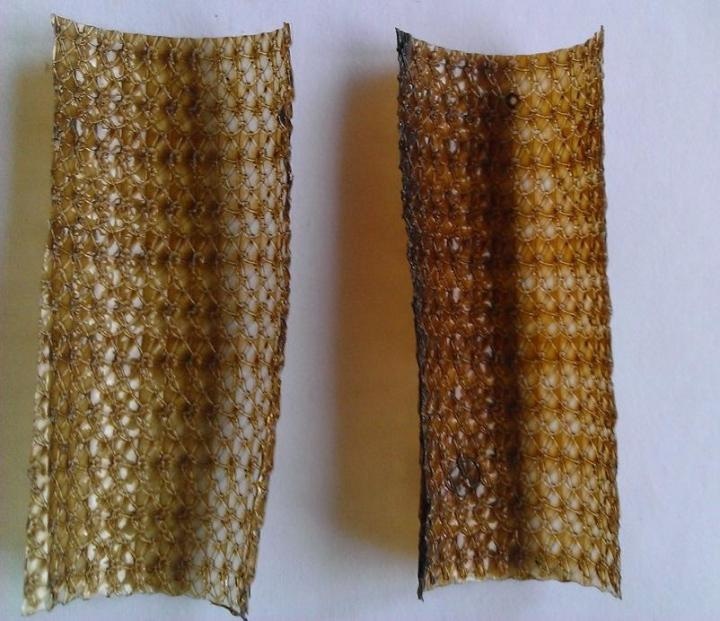Aug 8 2016
 These are coated polypropylene samples of implants (abdominal nets) (credit:Vladimir Zverev)
These are coated polypropylene samples of implants (abdominal nets) (credit:Vladimir Zverev)
An innovative method to apply the therapeutic effect of heating or cooling the tissues using the magnetocaloric effect (MCE) has been developed by a group of Russian physicists in collaboration with their Swiss colleagues.
The study results have been reported in the latest issue of the International Journal of Refrigeration.
A group of scientists from the Lomonosov Moscow State University (MSU) have suggested a new method for the targeted delivery of drugs to the implants using MCE. According to Vladimir Zverev (Lomonosov Moscow State University, Faculty of Physics), one of the authors of the paper, this is a unique method involving the use of a negative MCE.
Upon exposure to an external magnetic field, the temperature of the magnetic material increases or decreases based on the material. This effect is called MCE, which was initially discovered in the nineteenth century. However, this important physical phenomenon had been explained only in 1917.
Although only minimal research has been carried out on this subject over the past 100 years, researchers have been increasingly showing interest in recent decades. This is because of an important contribution towards the physics of magnetic materials and due to its wide range of potential applications.
It can be very successfully applied in low-temperature physics, for the manufacture of heat engines, refrigeration and much more.
However, most of these applications are not yet commercially available, mainly due to the lack of the technology. For example, although many scientific and industrial laboratories worldwide are developing domestic magnetic refrigerators today, the cost of such refrigerators would be very high if they were made today, said Vladimir Zverev, a member of the Physics Department of MSU.
For such a refrigerator magnetic field of around one Tesla is required, which at today's possibilities makes the prices very high and therefore commercially unacceptable - the very device to generate such a field will cost at least fifteen hundred dollars. It remains to wait for them to fall in price.
Vladimir Zverev, Physics Department, MSU
However, this did not stop the authors from proposing a new application of the magnetocaloric effect, almost ready for medical applications this time. One of the developed techniques is called "magnetic fluid hypothermia" and involves heating cancer tumors with specially engineered magnetic nanoparticles that can be directly delivered the tumor site.
To achieve this, the research team devised a unique tool to generate an alternating high-frequency magnetic field without any analogs in the world, says Vladimir Zverev.
Today, the primary research of different cancerous cell cultures is carried out with the help of this facility at the Blokhin Scientific Cancer Centre. At the facility, studies were also conducted on mice, which demonstrated that the microparticles are both non-toxic and biocompatible.
The tests on the pharmacokinetics of the microparticles are carried out as well, which show their ability of retention in the tumor site, reaching throughout the body with the blood flow, etc. If the possibility of applying such magnetocaloric effect in the scientific publication is at least cited. It is a known fact that the tumor may be degraded upon exposure to heating. However, the second method suggested by the researchers is unique.
It is a known fact that implanted foreign components in human-artificial joints, urinary and biliary ducts, stents esophagus, abdominal nets, and much more are the likelihood of rejection. The authors suggest the application of a special coating comprising of several layers to implants (yet at the stage of the preparation for installing).
The first layer consists of a magnetic material (a material with a negative magnetocaloric effect) that is cooled upon the application of an external magnetic field. This layer may be a suspension or a thin film of magnetic microparticles. The second layer is a polymer matrix that acts as a sponge to absorb the drug. The polymer matrix and the magnetocaloric material are in direct thermal contact. The whole structure is positioned in the body during the operation.
In this structure, the polymer matrix holds the drug within it by acting like jelly at the normal body temperature, i.e., at temperatures higher than 37 degrees. The polymer changes to a liquid state when the temperature is lowered by the magnetic field, releasing drugs at the site of the implantation. For example, inflammation occurs once the implant is inserted.
The ability to non-invasively apply an external magnetic field (for example, in MRI) enables the desired dose of drugs to be released at the desired place and time.
This technique of 'targeted' drug delivery is excellent, especially owing to the fact that it only targets the source of inflammation and keeps the rest of the body uninfluenced. Therefore, the technique is completely harmless. However, the problem to be addressed is what to do once the coated drug is over.
First, in some cases just a single drug input is need, for example, to paste the abdominal mesh. A release dosage portions of the drug can be controlled by regulating the magnitude of the external magnetic field. It is also possible to replenish the coat, using the fact that a drug may be chemically linked to the magnetic particles which can be 'dragded' to the desired location in the body by an external magnetic field. This method we haven't developed, however, and it is only ideas yet.
Vladimir Zverev, Physics Department, MSU